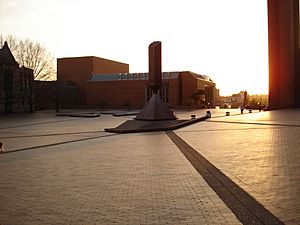Broken Obelisk facts for kids

Broken Obelisk is a famous sculpture created by Barnett Newman between 1963 and 1967. It's made from a special type of steel called Cor-Ten steel. This steel gets a cool rust-colored look over time. The sculpture weighs three tons and is the biggest and most well-known of Newman's six sculptures.
There are actually four copies, or "multiples," of Broken Obelisk around the world.
Contents
What is Broken Obelisk?
The Broken Obelisk sculpture looks like a pyramid with an upside-down obelisk on top. An obelisk is a tall, narrow, four-sided monument that ends in a pyramid shape. Newman's sculpture is unique because the obelisk part is inverted, meaning it points downwards into the pyramid.
History of the Sculptures
Barnett Newman designed Broken Obelisk to make people think. He wanted to create something that felt both ancient and new.
Early Sculptures and Display
The first two copies of Broken Obelisk were made in 1966–67. They were built by a company called Lippincott, Inc. in North Haven, Connecticut.
- One of the first sculptures was shown outside the Corcoran Gallery of Art in Washington, D.C. This was part of an art show in 1967.
- Another copy was displayed in front of the Seagram Building in New York City.
The sculpture in Washington, D.C., caused some talk. Some people thought it looked like a broken, upside-down Washington Monument. This was at a time when there was a lot of social change happening. The sculpture was later moved in 1969.
New Copies and Permanent Homes
A third copy of the sculpture was finished in 1969. This one had some improvements to its structure. It became a permanent part of the collection at the Museum of Modern Art in New York City.
For a short time, all three copies were together at the Lippincott, Inc. workshop.
- One copy was bought by John de Menil. It was installed in 1970 at the Rothko Chapel in Houston, Texas. This sculpture is surrounded by a pool of water. John de Menil wanted this specific sculpture to be dedicated to Martin Luther King Jr..
- Another copy was bought by Virginia Wright. It was placed in 1971 at Red Square on the campus of the University of Washington in Seattle.
The Fourth Sculpture
A fourth copy of Broken Obelisk was made much later. It was commissioned in 2003 and finished in 2005–06. This was done with permission from the Barnett Newman Foundation.
- This last sculpture was installed in front of the Neue Nationalgalerie in Berlin in 2007–08.
- Later, it was acquired by the Storm King Art Center in New York.
In the summer of 2014, all four sculptures were on display in the United States. You could find them at:
- Rothko Chapel, Houston
- University of Washington, Seattle
- Museum of Modern Art, New York City
- Storm King Art Center, New Windsor, New York
What Does it Mean?
Art critics have written about the meaning of Broken Obelisk.
A Deep Meaning
Art critic Robert Hughes wrote about Broken Obelisk in 1971. He said that Newman wanted to explore big ideas, not just nature. Hughes believed that Newman could take old shapes, like the obelisk and pyramid, and make them feel new and important again.
Hughes called Broken Obelisk "perhaps the best American sculpture of its time." He saw it as Newman's way of thinking about ancient Egypt. The sculpture has a steel pyramid with an inverted obelisk rising from it, like a beam of light.
Beyond Death
Hughes noted that pyramids and broken columns often make people think of death. However, Newman's sculpture was different. He created an image that celebrated life and rising above challenges.
The sculpture is quiet and powerful. It shows that for Newman, art was a way to understand the world. It was a way of gaining knowledge and exploring deep philosophical ideas.
See also
 In Spanish: Obelisco Roto para niños
In Spanish: Obelisco Roto para niños


